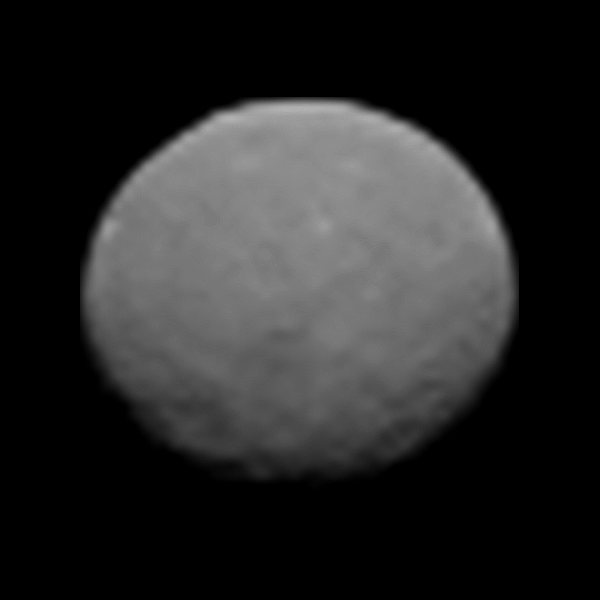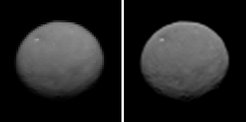Dawn: Large craters and a bright spot
NASA’s Dawn spacecraft has captured new images of dwarf planet Ceres. They show surface structures with a resolution of 22 kilometers per pixel.
Extensive craters and a striking bright spot can be seen on current images from NASA’s Dawn space probe, which is enroute to dwarf planet Ceres and has now photographed its destination from a distance of 237000 kilometers. The images that were taken on 25 January 2015 provide a spatial resolution of about 22 kilometers per pixel. For the first time, this value exceeds that of earlier images obtained with the Hubble Space Telescope. Scientists suspect that the bright spot might represent a comparatively young structure. The Framing Cameras aboard the Dawn spacecraft were developed under the leadership of the Max Planck Institute for Solar System Research (MPS). MPS researchers operate the instrument and evaluate the scientific data.

"The features earlier images had hinted at stand out more clearly now”, says Dr. Andreas Nathues from the MPS, Framing Camera Lead Investigator. "The surface appears to be dominated by large craters now coming into view," he adds. Many of these structures that appear as dark regions may extend over more than 100 kilometers.
In the current images Ceres faces the spacecraft with almost the same side as it did almost two weeks ago when the Framing Camera took its last glimpse of the distant destination. As before, a bright feature can be discerned on the northern hemisphere. “This bright spot possibly covers less than one pixel”, says Framing Camera team member Dr. Martin Hoffman from the MPS. "It is therefore still impossible to determine its exact size”, he adds.

A striking feature in both images is the bright spot in the northern hemisphere.
The scientists speculate that the bright spot might be a comparably young impact crater. Both on the giant asteroid Vesta, the first object studied by the Dawn mission, as well as on the moon, fresh craters are more brightly colored than older ones. In addition, the new images now suggest a darker region next to the spot ? possibly a shadow cast by the crater rim. “It will, however, take a few weeks before we can be sure”, says Nathues.
"Ceres looks very homogenous in terms of brightness compared to Vesta, but we are awaiting to see what lies near the South Pole as we are yet to image it”, says Dr. Vishnu Reddy from the Planetary Science Institute in Arizona (USA), another member of the Framing Camera team.
In the coming weeks and months, the Dawn scientists hope to shed light particularly upon the internal structure of the nearly spherical dwarf planet. It is believed that a layer of frozen or maybe even liquid water lies hidden beneath its surface. Thus, the dwarf planet would fundamentally differ from the rocky population of the inner asteroid belt such as Vesta. "The comparison of Ceres and Vesta could help us to understand why rocky bodies evolved in the inner solar system, while the outer solar system remained rich in water and other volatiles," says Nathues.
Dawn’s approach phase will last until late April. In March, the spacecraft will swing into an orbit around the dwarf planet. Until then, the images of the camera system on board will become clearer and clearer – and provide an increasingly better preview of a mysterious world.
The Dawn mission to Vesta and Ceres is managed by NASA’s Jet Propulsion Laboratory for NASA's Science Mission Directorate (SMD), Washington. It is a project of the Discovery Program, managed for SMD by NASA's Marshall Space Flight Center, Huntsville, Ala. The University of California, Los Angeles, is responsible for overall Dawn mission science. Orbital Sciences Corporation of Dulles, Va., designed and built the Dawn spacecraft. The framing cameras have been developed and built under the leadership of the Max Planck Institute for Solar System Research, Göttingen, Germany, with significant contributions by the German Aerospace Center (DLR) Institute of Planetary Research, Berlin, and in coordination with the Institute of Computer and Communication Network Engineering, Braunschweig. The framing camera project is funded by the Max Planck Society, DLR, and NASA.

